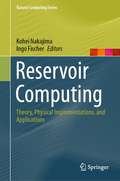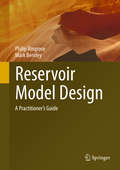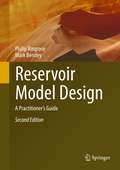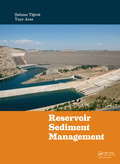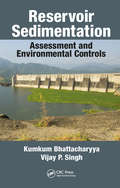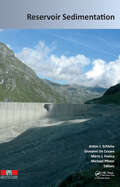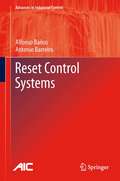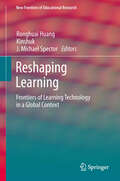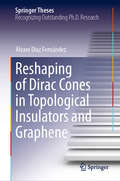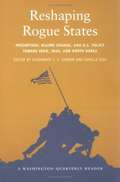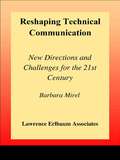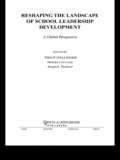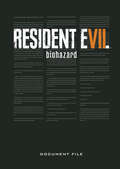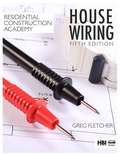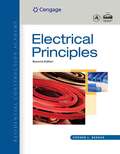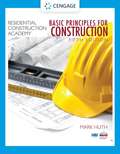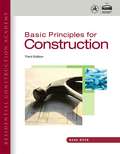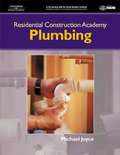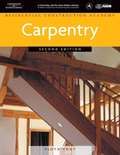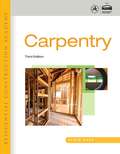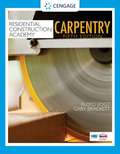- Table View
- List View
Reservoir Computing: Theory, Physical Implementations, and Applications (Natural Computing Series)
by Kohei Nakajima Ingo FischerThis book is the first comprehensive book about reservoir computing (RC). RC is a powerful and broadly applicable computational framework based on recurrent neural networks. Its advantages lie in small training data set requirements, fast training, inherent memory and high flexibility for various hardware implementations. It originated from computational neuroscience and machine learning but has, in recent years, spread dramatically, and has been introduced into a wide variety of fields, including complex systems science, physics, material science, biological science, quantum machine learning, optical communication systems, and robotics. Reviewing the current state of the art and providing a concise guide to the field, this book introduces readers to its basic concepts, theory, techniques, physical implementations and applications.The book is sub-structured into two major parts: theory and physical implementations. Both parts consist of a compilation of chapters, authored by leading experts in their respective fields. The first part is devoted to theoretical developments of RC, extending the framework from the conventional recurrent neural network context to a more general dynamical systems context. With this broadened perspective, RC is not restricted to the area of machine learning but is being connected to a much wider class of systems. The second part of the book focuses on the utilization of physical dynamical systems as reservoirs, a framework referred to as physical reservoir computing. A variety of physical systems and substrates have already been suggested and used for the implementation of reservoir computing. Among these physical systems which cover a wide range of spatial and temporal scales, are mechanical and optical systems, nanomaterials, spintronics, and quantum many body systems. This book offers a valuable resource for researchers (Ph.D. students and experts alike) and practitioners working in the field of machine learning, artificial intelligence, robotics, neuromorphic computing, complex systems, and physics.
Reservoir Geomechanics
by Mark D. ZobackA practical reference for geoscientists and engineers in the petroleum and geothermal industries.
Reservoir Model Design
by Philip Ringrose Mark BentleyThis book gives practical advice and ready to use tips on the design and construction of subsurface reservoir models. The design elements cover rock architecture, petrophysical property modelling, multi-scale data integration, upscaling and uncertainty analysis. Philip Ringrose and Mark Bentley share their experience, gained from over a hundred reservoir modelling studies in 25 countries covering clastic, carbonate and fractured reservoir types. The intimate relationship between geology and fluid flow is explored throughout, showing how the impact of fluid type, production mechanism and the subtleties of single- and multi-phase flow combine to influence reservoir model design. Audience: The main audience for this book is the community of applied geoscientists and engineers involved in the development and use of subsurface fluid resources. The book is suitable for a range of Master's level courses in reservoir characterisation, modelling and engineering. · Provides practical advice and guidelines for users of 3D reservoir modelling packages · Gives advice on reservoir model design for the growing world-wide activity in subsurface reservoir modelling · Covers rock modelling, property modelling, upscaling and uncertainty handling · Encompasses clastic, carbonate and fractured reservoirs
Reservoir Model Design: A Practitioner's Guide
by Philip Ringrose Mark BentleyThis book gives practical advice and ready to use tips on the design and construction of subsurface reservoir models. The design elements cover rock architecture, petrophysical property modelling, multi-scale data integration, upscaling and uncertainty analysis. Philip Ringrose and Mark Bentley share their experience, gained from over a hundred reservoir modelling studies in 25 countries covering clastic, carbonate and fractured reservoir types, and for a range of fluid systems – oil, gas and CO2, production and injection, and effects of different mobility ratios. The intimate relationship between geology and fluid flow is explored throughout, showing how the impact of fluid type, displacement mechanism and the subtleties of single- and multi-phase flow combine to influence reservoir model design.The second edition updates the existing sections and adds sections on the following topics:· A new chapter on modelling for CO2 storage· A new chapter on modelling workflows· An extended chapter on fractured reservoir modelling· An extended chapter on multi-scale modelling· An extended chapter on the quantification of uncertainty· A revised section on the future of modelling based on recently published papers by the authorsThe main audience for this book is the community of applied geoscientists and engineers involved in understanding fluid flow in the subsurface: whether for the extraction of oil or gas or the injection of CO2 or the subsurface storage of energy in general. We will always need to understand how fluids move in the subsurface and we will always require skills to model these quantitatively. The second edition of this reference book therefore aims to highlight the modelling skills developed for the current energy industry which will also be required for the energy transition of the future. The book is aimed at technical-professional practitioners in the energy industry and is also suitable for a range of Master’s level courses in reservoir characterisation, modelling and engineering.• Provides practical advice and guidelines for users of 3D reservoir modelling packages• Gives advice on reservoir model design for the growing world-wide activity in subsurface reservoir modelling• Covers rock modelling, property modelling, upscaling, fluid flow and uncertainty handling• Encompasses clastic, carbonate and fractured reservoirs • Applies to multi-fluid cases and applications: hydrocarbons and CO2, production and storage; rewritten for use in the Energy Transition.
Reservoir Sediment Management
by Sahnaz Tigrek Tuce ArasSiltation in reservoirs has become an important problem when dams are getting older and stop functioning when the sediment has accumulated to a certain extent. With proper sediment management techniques, negative effects of sediment can be avoided and reservoir life and performance can be improved.This volume deals with reservoir sedimentation, dep
Reservoir Sedimentation: Assessment and Environmental Controls
by Kumkum Bhattacharyya Vijay P. SinghReservoir Sedimentation: Assessment and Environmental Controls appraises the issues of sedimentation in reservoirs and discusses measures that can be employed for the effective management of sediment to prolong the operational life of reservoirs. It provides information for professional consultants and policymakers to enable them to manage dams in the best possible way, in order to ensure their sustainability as well as the sustainability of water resources in general. It examines the effects of anthropogenic intervention and management of sediment in dams and reservoirs, as water resources become more sensitive and the demand for clean water continues to increase. Features: Examines the issue of sedimentation in dams and reservoirs and presents water management strategies to alleviate environmental issues Presents methods to help ensure the environmental sustainability of dams and reservoirs, as well as the sustainability of water resources- with consideration of climate change and increased demand Illustrates the spatial distribution of sedimentation characteristics for several dams using geographic information systems (GIS) Explains the relationships between loss in capacity and catchment characteristics Examines regional variation in sediment yield, defines geomorphic regions on the basis of similar hydrometeorology, physiography, geology, and vegetation affecting reservoirs
Reservoir Sedimentation
by Anton J. Schleiss Giovanni De Cesare Mário J. Franca Michael PfisterDespite the mechanisms of reservoir sedimentation being well known for a long time, sustainable and preventive measures are rarely taken into consideration in the design of new reservoirs. To avoid operational problems of powerhouses, sedimentation is often treated for existing reservoirs with measures which are efficient only for a limited time.
Reset Control Systems
by Antonio Barreiro Alfonso BañosReset Control Systems addresses the analysis for reset control treating both its basic form, and some useful variations of the reset action and reset condition. The issues regarding reset control - concepts and motivation; analysis tools; and the application of design methodologies to real-world examples - are given thorough coverage. The text opens with a historical perspective which moves from the seminal work of the Clegg integrator and Horowitz FORE to more recent approaches based on impulsive/hybrid control systems and explains the motivation for reset compensation. Preliminary material is also included. The focus then turns to stability analysis for systems using techniques which account for various time- and frequency-domain criteria. The final section of the book is centered on control systems design and application. The PI+CI compensator is detailed as are a proposed frequency domain approach using quantitative feedback theory and ideas for design improvement. Design examples are given.
Reshaping Environments: An Interdisciplinary Approach to Sustainability in a Complex World
by Helena BenderReshaping Environments: An Interdisciplinary Approach to Sustainability in a Complex World draws together a team of specialist authors from disciplines including urban planning, social sciences, engineering and environmental science to examine the diverse influences humans have upon the natural environment. This interdisciplinary approach presents multifaceted responses for complex environmental issues. The book explores current environmental science theories to provide a solid foundation of theoretical knowledge. Drawing on a range of case studies, it develops core analytical skills for application to real-world environmental issues. Reshaping Environments gives environmental science students the tools and insight to comprehend the range of influences society imposes on the natural environment. It is essential reading for those interested in creating a mutually beneficial future for human society and the natural environment.
Reshaping Learning
by Ronghuai Huang J. Michael Spector KinshukThis edited volume with selected papers from extinguished experts and professors in the field of learning technology and the related fields who are far-sighted and have his/her own innovative thoughts on the development of learning technology. This book will addresses the main issues concerned with the trend and future development of learning processes, innovative pedagogies changes, effects of new technologies on education, future learning content. Learning technology has been affected by advances in technology development and changes in the field of education. Nowadays we cannot afford to sense the changes and then make adaption to it. What we should do is to predict the changes and make positive and active reactions to help the trend go smoothly and in a more beneficial way. This book aims to gather the newest ideas on the frontiers and future development of learning education from the aspects of learning, pedagogies, and technologies in learning in order to draw a picture of learning education in the near future.
Reshaping of Dirac Cones in Topological Insulators and Graphene (Springer Theses)
by Álvaro Díaz FernándezDirac cones are ubiquitous to non-trivial quantum matter and are expected to boost and reshape the field of modern electronics. Particularly relevant examples where these cones arise are topological insulators and graphene. From a fundamental perspective, this thesis proposes schemes towards modifying basic properties of these cones in the aforementioned materials. The thesis begins with a brief historical introduction which is followed by an extensive chapter that endows the reader with the basic tools of symmetry and topology needed to understand the remaining text. The subsequent four chapters are devoted to the reshaping of Dirac cones by external fields and delta doping. At all times, the ideas discussed in the second chapter are always a guiding principle to understand the phenomena discussed in those four chapters. As a result, the thesis is cohesive and represents a major advance in our understanding of the physics of Dirac materials.
Reshaping Rogue States: Preemption, Regime Change, and U.S. Policy Toward Iran, Iraq, and North Korea
by Alexander T. J. Lennon Camille EissIn January 2002, President George W. Bush declared Iran, Iraq, and North Korea constituents of an "axis of evil."
Reshaping Technical Communication: New Directions and Challenges for the 21st Century
by Barbara Mirel Rachel SpilkaThis anthology brings together voices from industry and academia in a call for elevating the status, identity, value, and influence of technical communicators. Editors Barbara Mirel and Rachel Spilka assert that technical communicators must depart from their traditional roles, moving instead in a more influential and expansive direction. To help readers explore the possibilities, contributions from innovative thinkers and leaders in technical communication propose ways to redefine the field's identity and purposes and to expand the parameters of its work. The chapters included here all point toward new directions for greater growth and influence of the field. Contributors depart from traditional ideas and solutions and discuss new and in some cases radical points, provoking further thought and discussion. Its exploration of fresh territory uncovers new research topics and directions, and provides an examination of both internal, industry-academia relationships and external relationships between technical communicators and other professionals. In its entirety, this collection represents an inclusive vision for the future, targeting such wide-ranging issues as creating effective professional organizations, disseminating research to diverse audiences, transitioning to more influential job roles, exerting leadership in usability, and creating hybrid identities and collaborative programs between industry and academic to support them. The diverse voices from industry and academia will inspire readers to think differently about the discipline's identity and direction, and to build on the ideas they find herein to effect change within their own spheres. As required reading for academics and professionals in technical communication, this collection is a critical step in reshaping and reinvigorating the technical communication field to ensure its survival and growth in the 21st century.
Reshaping the Landscape of School Leadership Development: A Global Perspective (Contexts Of Learning Ser.)
by Philip HallingerReshaping the Landscape of School Leadership Development: A Global Perspective traces developments in this arena as they evolved since 1980. The book is comprised of chapters authored by the leading scholars in the fields of educational leadership and school leadership development from the United States, Canada, Europe, Asia, and Australia. The vol
Resident Duty Hours: Enhancing Sleep, Supervision, and Safety
by Committee on Optimizing Graduate Medical Trainee (Resident) Hours Work Schedules to Improve Patient SafetyMedical residency in the United States aims to prepare recent medical school graduates to practice medicine independently. One fundamental requirement of resident education is in-depth, firsthand experience caring for patients. During the three to seven years of training, residents often work long hours with limited time off to catch up on their sleep. They can experience fatigue on the job, contributing to increased errors and accidents. However, many medical educators believe extensive duty hours are essential to provide residents with the educational experiences they need to become competent in diagnosing and treating patients. Resident Duty Hours: Enhancing Sleep, Supervision, and Safety, a December 2008 report from the IOM, asserts that revisions to medical residents' workloads and duty hours are necessary to better protect patients against fatigue-related errors and to enhance the learning environment for doctors in training. The report recommends that residency programs provide regular opportunities for sleep each day and each week during resident training. In addition, it recommends that the Accreditation Council for Graduate Medical Education provide better monitoring of duty hour limits and that residency review committees set guidelines for residents' patient caseload. Patient handover procedures and supervision of residents should also be strengthened. Until these changes take place, residency programs are not providing what the next generation of doctors or their patients deserve.
Resident Evil 7: Biohazard Document File
by CapcomAn in-depth, 152-page art book that ventures into the challenges recorded throughout the production of the critically acclaimed, fan-adored Resident Evil 7: Biohazard!Relive the terror of Resident Evil 7: Biohazard, the expertly crafted first-person survival horror game that altered the paradigm of Resident Evil titles. This art book includes undisclosed concept art and CG visuals closely arranged and coupled with detailed passages of the development team's progress on the game. Explore interviews, photo albums, a storyboard collection of in-game event scenes from opening to ending, and more in this succinctly packed chronicle of Resident Evil 7's development. Dark Horse Books and Capcom present Resident Evil 7: Biohazard Document Files, a perfect companion for fans of Resident Evil, and fully translated to English for the first time!
Residential Carpentry: Student Guide Level 2
by Nccer StaffThe material in this textbook will help you prepare for a career in residential carpentry.
Residential Construction Academy: Basic Principles For Construction
by Mark HuthFeaturing a full color design with a wide range of photos and figures that reflect today's construction practices, this Fourth Edition has been updated throughout to ensure that students stay current with industry standards and trends. Known for its basic, step-by-step approach, RESIDENTIAL CONSTRUCTION ACADEMY: BASIC PRINCIPLES FOR CONSTRUCTION, 4E, is ideal for those beginning a career in the building trades industry. Readers will find thorough, up-to-date coverage of basic skills and important tasks necessary for success in the field, such as work ethics, safety procedures, constuction mathematics, communications, print reading, and common tools. Unlike traditional building trade volumes, Huth's popular book also provides information on construction careers. Created in partnership with the Home Builders Institute (HBI), the workforce development arm of the National Association of Home Builders (NAHB), the Residential Construction Academy Series is the only program based on the National Skill Standards for residential construction.
Residential Construction Academy: Basic Principles for Construction
by Mark W. HuthRESIDENTIAL CONSTRUCTION ACADEMY: BASIC PRINCIPLES FOR CONSTRUCTION, 3E includes a full color design with new and updated photos and figures. Coverage of building codes and safe materials handling ensures that the reader will stay current with industry standards and trends. In addition, a new chapter on green building practices will introduce readers to jobsite practices while they plan and execute. This book is ideal for those beginning a career in the building trades industry and provides thorough, up-to-date coverage of the core academic areas that are necessary for success in the field. Topics include work ethic, math, communications, print reading, safety, and common tools.
Residential Construction Academy: Plumbing
by Michael A. JoyceCreate a direct link between your education/training program and the residential construction industry! Training materials are now available for many of the residential crafts based on skill standards developed by the nation's leading builders and educators. The result of a strategic partnership between the National Association of Home Builder's Home Builders Institute and Delmar, the Residential Construction Academy Series is the perfect way to teach essential workplace skills to people new to the building trades. Delmar is a part of Cengage Learning. Written in partnership with the Home Builders Institute, and endorsed by NAHB, Residential Construction Academy Plumbing provides a step-by-step approach to residential plumbing installations. Focusing on the new residential construction industry, the author thoroughly explains the process of installing residential plumbing systems by exploring topics such as tools of the trade and proper safety measures and by offering various tips to increase productivity on-the-job. Logically organized to build a foundation of knowledge, the text progresses from the installation of common fixtures to troubleshooting techniques that will aid apprentice and plumber alike. An emphasis on creative layout and the importance of understanding code variations fosters an understanding of plumbing system installation that is based on typical situations as well as unique jobsite conditions.
Residential Construction Academy: Carpentry
by Floyd VogtThis new edition for Carpentry from Delmar's Residential Construction Academy Series, introduces users to skills and information required to work professionally on any job site. Based on nationally-recognized standards set by the construction industry, this book is organized into four sections; "Tools and Materials", "Rough Carpentry", "Exterior Finish", and "Interior Finish". New topics have been added in this edition to the Power Tool, Building Foundation, Wall Framing and Finish Carpentry chapters. Extensively illustrated and succinctly written, nearly every chapter contains special "Procedure" sections that combine precise, step-by-step instructions with helpful drawings, making it easy to master tasks. Safety is emphasized and safety cautions are highlighted throughout. Definitions of industry terms at the start of each chapter are also included to help facilitate learning.
Residential Construction Academy: Carpentry (Third Edition)
by Floyd VogtBased on industry standards developed by the National Association of Home Builders and its Home Builders Institute, this comprehensive text covers the essentials of residential construction carpentry, including tools and materials, rough carpentry, and exterior and interior finish carpentry ensuring professional success on any jobsite. Extensively illustrated and succinctly written, RESIDENTIAL CONSTRUCTION ACADEMY: CARPENTRY 3e features "Procedure" sections in nearly every chapter that combine precise, step-by-step instructions with helpful drawings, making it easy to understand key concepts and master important techniques. The Third Edition includes much new and updated material, including special "green" features exploring environmentally friendly building practices, and exercises incorporating local building codes. As always, safety is strongly emphasized with specific tips and precautions in every chapter.
Residential Construction Academy: Carpentry
by Floyd Vogt Gary BrackettCreated in partnership with the National Association of Home Builders (NAHB) and its Home Builders Institute (HBI), this best-selling resource uses a visual, practical, instructional approach to teach students how to build a home and help them develop essential workplace skills. RESIDENTIAL CONSTRUCTION ACADEMY: CARPENTRY, Fifth Edition, provides a logical, sequential introduction to essential construction topics. Each chapter begins with learning objectives and a glossary, features relevant pictures and diagrams to reinforce key ideas, and concludes with construction procedures and review questions. Throughout the text, the authors also highlight important techniques, tools, materials, code requirements, and best practices associated with constructing a residential building.
